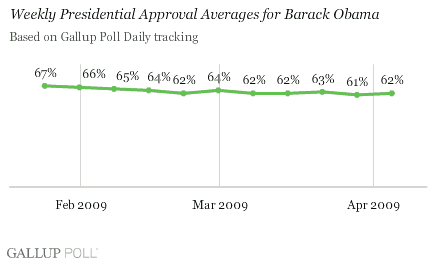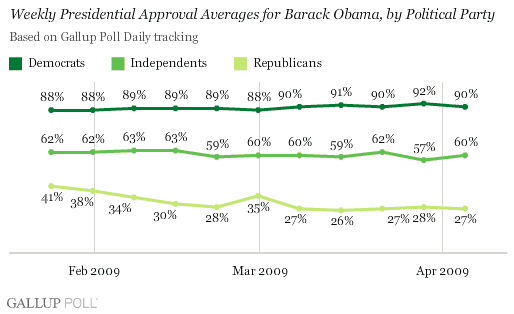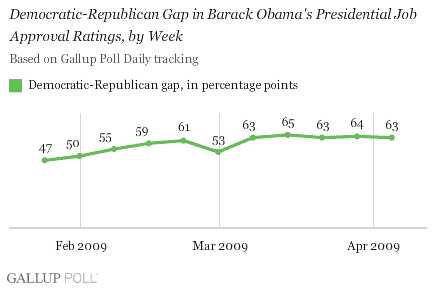PRINCETON, NJ -- President Barack Obama's overall job approval rating has been highly stable since mid-February, averaging 62% since Feb. 16, as well as in the most recent week, from March 30 through April 5.

Still enjoying a honeymoon period, Obama's approval rating has fallen only slightly from its 67% starting point even as he has outlined an ambitious agenda that has been controversial to some with regard to the costs to taxpayers and the proposed expansion of the federal government's role in the economy.
So far, Obama's actions have served to turn off only a rather limited number of Republicans. He began his term with a 41% approval rating among Republicans -- not outstanding but certainly healthy when juxtaposed against the largely single-digit approval ratings for George W. Bush among Democrats in the last year and a half of his presidency.
Obama's approval rating among Republicans declined rather quickly in the weeks after his inauguration and was 27% this past week. So even though he still claims a substantial minority of Republicans as supporters, this group is about one-third smaller than at the outset of his presidency.
Meanwhile, Obama's approval ratings among Democrats and independents have been highly stable. Last week's averages of 90% approval from Democrats and 60% from independents nearly match the averages for his presidency to date.

The drop in Republican support, coupled with the high and stable approval ratings from Democrats, has led to a widening partisan gap in evaluations of Obama. After beginning at 47 points between Democrats (88%) and Republicans (41%), the gap in approval stood at 63 points in last week's data (90% versus 27%).

Partisan Gaps in Historical Context
Partisan gaps in presidential job approval are nothing new -- Gallup has consistently observed Democratic-Republican differences in ratings of the president since it began measuring job approval ratings in the 1940s. But for many recent presidents, the gap has far exceeded the historical norm.
For the seven presidents from Harry Truman to Jimmy Carter, the median or typical partisan gap in presidential approval rating was 35 points. That began to change during Ronald Reagan's presidency, as he ushered in a new era of conservative policies that did not sit well with most Democrats. Consequently, during his tenure in office, the median party gap in approval ratings was 53 points.
George H.W. Bush succeeded Reagan, promising a "kinder, gentler" approach to governing, and his ratings were less polarized and more in line with the historical data, with a median 37-point party gap.
But Bush's record was a bit of an anomaly in recent history. Bill Clinton's policies and -- perhaps more importantly -- his personal behavior were problematic for most Republicans, and during his presidency, the typical party gap in approval ratings was 55 points.
George W. Bush succeeded Clinton and set new standards for political polarization, with a median 64-point difference between Republicans' and Democrats' ratings of him, including record 83-point party divides in the fall of 2004.
To this point, the typical party gap for Barack Obama has been 61 points. This puts him much more in line with the recent Bush record than with earlier presidents.
To the extent Republicans are evaluating Obama on the substance of his policies and proposals (particularly his domestic policies) there may be little for them to like, since Obama's policies have largely followed usual Democratic doctrine. Thus, a wide partisan gap is understandable -- even for a president trying to avoid one. But Obama's best efforts at creating a post-partisan presidency are complicated by the ideological hegemony within the congressional party caucuses and the partisan pundits filling the airwaves, print pages, and blogosphere, seeking to convince those who watch, listen, or read of the correctness of their views and the incorrectness of their opponents' views. In such an environment, it is not surprising that George W. Bush's later approval ratings were in single digits among Democrats while he maintained rather healthy ratings among Republicans.
These forces may help to explain the stability in Obama's approval rating among all Americans, as well as the large partisan divide in his public evaluations.
Survey Methods
Results are based on telephone interviews with 3,559 national adults, aged 18 and older, conducted March 30-April 5, 2009, as part of Gallup Poll Daily tracking. For results based on the total sample of national adults, one can say with 95% confidence that the maximum margin of sampling error is ±2 percentage points.
Interviews are conducted with respondents on land-line telephones (for respondents with a land-line telephone) and cellular phones (for respondents who are cell-phone only).
In addition to sampling error, question wording and practical difficulties in conducting surveys can introduce error or bias into the findings of public opinion polls.
